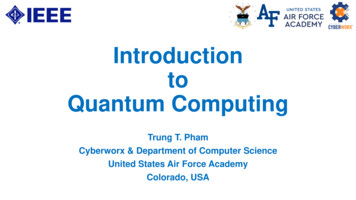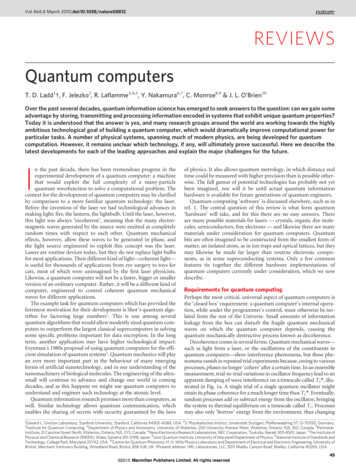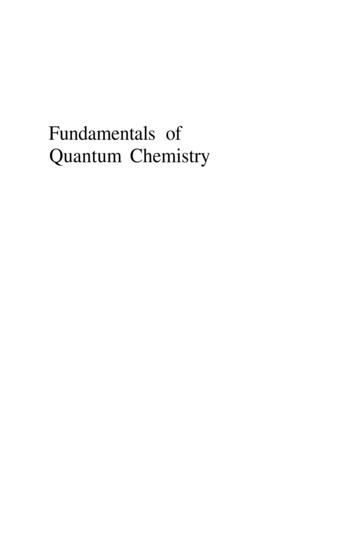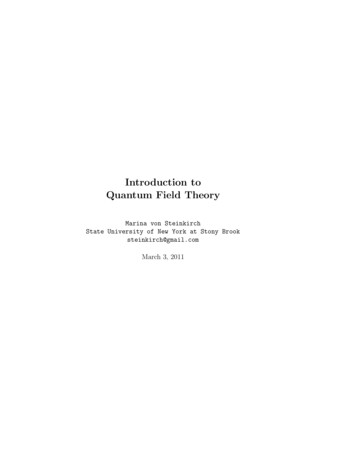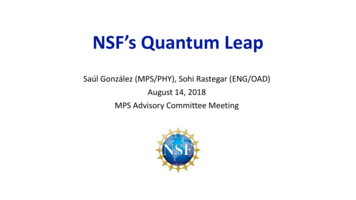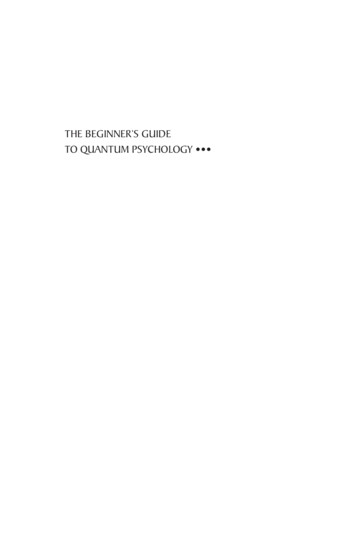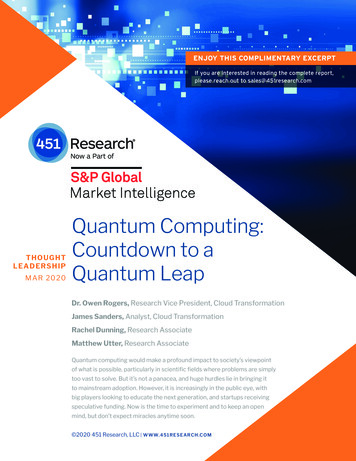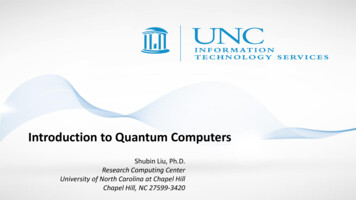
Transcription
Introduction to Quantum ComputersShubin Liu, Ph.D.Research Computing CenterUniversity of North Carolina at Chapel HillChapel Hill, NC 27599-3420
Objectives & Prerequisites After this workshop, you should be Familiar with basics and general trends of quantum computers Able to understand simple quantum circuits Ready to build and run simple quantum computing tasks with QISKit We assume that you know Basic knowledge of linear algebra and statistics, but not mandatory No prior knowledge of quantum mechanics required Recommendation: An account @ IBM Quantum Experiencehttps://quantum-computing.ibm.com2
A BEGINNER'S GUIDE TO QUANTUM COMPUTING Shohini Ghosehttps://www.youtube.com/watch?v QuR969uMICM
Agenda What is a Quantum Computer? Brief history, quantum mechanics, current status Basic Concepts of Quantum Computers Qubit, superposition, entanglement, decoherence,measurement Quantum gates, quantum circuits, quantum algorithm How does a Quantum Computer work? Requirements of quantum computer Quantum computer design & roadmap Applications of Quantum Computers Quantum optimization Quantum chemistry and materials Quantum communication Case studies: cryptography, Shor algorithm, variationalquantum eigensolver DEMO: Quantum Computing with QISKit4
About Myself Ph.D. degree, quantum chemist by training, UNC-CH Chemistry Senior Computational Scientist @ Research Computing Center, UNC-CH Engagement group, training, collaboration, etc. https://shubin.web.unc.edu/ Research Interests: Development of density functional theory and itsapplications in biology, energy and drug design (using HPC/HTC clusters)5
Moore’s law & Future of istorsMoore's law is the observationMoore’s law will soonthat the number of transistors in adense integrated circuit doubles run into majorphysical constraints!about every two years.Moore, G. E. Electronics 8, 114–117 (1965).Image from: Ferain, I. et al.,Nature 479, 310–316 2040“There's Plenty of Room at the Bottom” (1959)“When we get to the very, very small world – say circuits of sevenatoms – we have a lot of new things that would happen thatrepresent completely new opportunities for design.Atoms on a small scale behave like nothing on a large scale,6Richard Feynman for they satisfy the laws of quantum mechanics ”
What is a quantum computer? Quantum Computer A computer that uses laws of quantum mechanics to perform massivelyparallel computing through superposition, entanglement, and decoherence. Classical Computer A computer that uses voltages flowing through circuits and gates, whichcan be controlled and manipulated entirely by classical mechanics.7
Evolution of Quantum Theory & Quantum TechnologyThe FoundationsFrom Theory to PracticeCommercialization & Application2020: Chinese scientistsclaimed 100 trillion fasterof quantum supremacy1980201020211900’s1925: SchrödingerEquation proposed8
Brief History of Quantum Computers 1981: Richard Feynman proposed to use quantum computing to model quantum systems. Healso describe theoretical model of quantum computer 1985: David Deutsch described first universal quantum computer 1994: Peter Shor developed the first algorithm for quantum computer (factorization intoprimes) 1995 Schumacher proposed “Quantum bit” or “qubit” as physical resource 1996: Lov Grover developed an algorithm for search in unsorted database 1998: the first quantum computers on two qubits, based on NMR (Oxford; IBM, MIT, Stanford) 2000: quantum computer on 7 qubits, based on NMR (Los-Alamos) 2001: 15 3 x 5 on 7- qubit quantum computer by IBM 2005-2006: experiments with photons; quantum dots; fullerenes and nanotubes as "particletraps"9
Brief History of Quantum Computers 2007: D-Wave announced the creation of a quantum computer on 16 qubits 2012: D-Wave claimed a quantum computation using 84 qubits 2017: D-Wave Systems Inc. announced the D-Wave 2000Q quantum annealer with 2000 qubits 2017: Microsoft revealed Q Sharp with 32 qubits 2018: Google announced the creation of a 72-qubit quantum chip 2019: Google claimed quantum supremacy with 54 qubits to perform operations in 200seconds that would take a supercomputer about 10,000 years to complete 2019: IBM revealed 53 qubits 2020: Chinese researchers claimed to have achieved quantum supremacy using a photonic 76qubit system at 100 trillion times the speed of classical supercomputers 2020: IBM will build 1121-qubit quantum computer in 2023, and 1 million-qubit quantumcomputer in 2030.10
Quantum MechanicsQuantum mechanics is the theory that describes the behavior of microscopicsystems, such as photons, electrons, atoms, molecules, etc.Nobody understands quantum mechanics!“No, you’re not going to be able to understand it. You see, my physicsstudents don’t understand it either. That is because I don’t understand it.Nobody does. . The theory of quantum electrodynamics describes Natureas absurd from the point of view of common sense. And it agrees fully withan experiment. So I hope that you can accept Nature as She is – absurd”--Richard Feynman11
Classical vs. Quantum MechanicsClassical Mechanics It deals with macroscopic particles It is based on Newton’s laws ofmotion and Maxwell’selectromagnetic wave theory Any amount of energy may beemitted or absorbed continuously The state of a system is definedexactly by specifying their positionsand velocities The future state can be predictedwith certaintyQuantum Mechanics It deals with microscopic particles It is based on the Schrödinger equation In Planck’s postulation, only discretevalues of energy are emitted or absorbed– origin of “quantum” Because of Heisenberg’s uncertaintyprinciple and de Broglie hypothesis dualnature of matter (both particle & wave),the state of a system cannot be specifiedexactly It gives probabilities of finding particles atvarious locations in space12
Quantum Mechanics Quantum states, represented byDirac’s ket, , evolve in timeaccording to the Schrödinger equation: which implies that time evolution isdescribed by unitary transformations: where is the quantum state(wavefunction) and H is Hamiltonian This theory, which has beenextensively tested by experiments, isprobabilistic in nature. The outcomesof measurements on quantumsystems are not deterministic. Between measurements, quantumsystems evolve according to linearequations (the Schrödinger equation).This means that solutions to theequations obey a superpositionprinciple: linear combinations ofsolutions are still solutions.13
Unitary Transformation as Quantum Computing0PREPARATION:The initial preparation of the state defines awave function at time t0 0. Ψ(0) U(t1,t0)1 Ψ(1) STATE EVOLUTION:Evolved by a sequence of unitary operationsU(t2,t1) . .U(tn,tn-1)n Ψ(n) P(Ф) Ф Ψ(n) 2MEASUREMENT:Quantum measurement is projective.Collapsed by measurement of the stateClassical Computing Approach using Flow Chart14
Unitary Transformation as Quantum ComputingOn a quantum computer, programs are executed by unitary evolution of an inputthat is given by the state of the system, n , which can in either 0 or 1 state.Since all unitary operators are invertible, we can always reverse or ‘uncompute’ acomputation on a quantum computer.Quantum Computing Approach using Quantum Circuit15
What does a quantum computer look like?Chinese 76-qubit photon-based quantum computerIonQ, ion-trap-based 32-qubit quantum computerIBM 53-qubit superconductor-based quantum computer16
Quantum Computing Race - CorporationsR&D investments reach 10.7 billion by 202417
YEAR 202018
Quantum Bit - Qubit The smallest unit of information in a quantum computer It represents the state of the wavefunction in Schrödingerequation A qubit may be in the “on” (1) state or in the “off” (0) state Many ways to implement a qubit: Nuclear spin in NMR: 0 , 1 .Photons in a cavity: 0 photon 0 , 1 photon 1 Energy states of an atom: g.s. 0 , excited state 1 Polarization of photon, many others .Transistor19
Quantum Bit - Qubit Since quantum systems evolve according to linear equations (theSchrödinger equation), linear combinations of solutions are alsosolutions. So, for the state of a qubit 0 and 1 , its superpositionalso describes the same state The general form of a qubit state can be represented by: 0 0› 1 1›where 0 and 1 are complex numbers that specify the probabilityamplitudes of the corresponding states. 0 2 gives the probability that you will find the qubit in the “off”(0) state; 1 2 gives the probability that you will find the qubit inthe “on” (1) state. Normalization condition: 0 2 1 2 1 e i cos 0 e i sin 1 22ˆz 0 ψ θyˆφxˆBloch Sphere20-zˆ 1
Classical Bit vs. Quantum BitCLASSICAL BITS: can be in two distinctstates, 0 and 1 can be measuredcompletely are not changed bymeasurement can be copied can be erasedQUANTUM BITS: can be in state 0 or in state 1 or in any other state that is a linearcombination of the two states can be measured partially withgiven probability are changed by measurement cannot be copied cannot be erased21
Advantages of Qubits & Enormous Quantum Power Adding qubits increases storage exponentially Quantum computer doubles the power with every added qubit To double the power of a digital computer 32bits - 64 bits To double the power of a quantum computer 32qubits - 33 qubits Can do operations on all superpositions like massively parallel computation One math operation on 2n numbers encoded in classical computers with n bitsrequires 2n steps or parallel processors, but the same operation on 2n numbersencoded by n qubits takes 1 step A 64-bit computer can perform manipulation on 64-bit binary numbers at a time. A 64-qubit quantum computer operates in a space of 264 dimensions, or roughly16,000,000,000,000,000,000 (16*1018) numbers to specify the state of the quantum system. This makes complex problems much easier to solve by quantum computer22
However, Quantum Systems are SPOOKY!Schrödinger’s Cat: SuperpositionSchrödinger’sCat in a blackboxEntanglement“I cannot seriously believe in [the quantum theory] because it cannot bereconciled with the idea that physics should represent a reality in time23 andspace, free from spooky actions at a distance.” Albert Einstein, March 1947.
Superposition Every quantum state can be represented as a sum of two or more other distinct states.Mathematically, it refers to a property of solutions to the Schrödinger equation; since theSchrödinger equation is linear, any linear combination of solutions will also be a solution. A single qubit can be forced into a superposition of the two states denoted by the addition of thestate vectors: 0 0 1 1 Where 0 and 1 are complex numbers and 0 2 1 2 1A qubit in superposition is in both of the states 1 and 0 at the same timeIf this state is measured, we see only one or the other state (live or dead) with some probability.The classic example of superposition is Schrödinger’s Cat in a black box. Since both a living anddead cat are obviously valid solutions to the laws of quantum mechanics, a superposition of thetwo should also be valid. Schrödinger described a thought experiment that could give rise tosuch a state.Consider a 3-qubit register. An equally weighted superposition of all possible states would bedenoted by: 1 000 1 001 . . . 1 111 8 8 824
Entanglement When a pair or group of particles is generated, interact, or share spatial proximity in a way suchthat the quantum state of each particle of the pair or group cannot be described independentlyof the state of the others, even when the particles are separated by a large distance. An entangled pair is a single quantum system in a superposition of equally possible states. Theentangled state contains no information about the individual particles, only that they are inopposite states. If the state of one is changed, the state of the other is instantly adjusted to be consistent withquantum mechanical rules. If a measurement is made on one, the other will automatically collapse. Quantum entanglement is at the heart of the disparity between classical and quantum physics:entanglement is a primary feature of quantum mechanics lacking in classical mechanics. Entanglement is a joint characteristic of two or more quantum particles. Einstein called it “spooky actions at a distance”25
EntanglementSuppose that two qubits are in states: 0 1 ' 0 ' 1The state of the combined system is their tensor product:(α 0 β 1 )(α' 0 β ' 1 ) αα' 00 αβ ' 01 βα' 10 ββ ' 11Question: what are the states of the individual qubits for1. 1 00 1 01 1 10 1 1122.12200 212112an independent statean entangled state26
Decoherence Quantum decoherence is the loss of superposition, because of thespontaneous interaction between a quantum system and itsenvironment. Decoherence can be viewed as the loss of information from a systeminto the environment. The reason why quantum computers still have a long way to gobecause superposition and entanglement are extremely fragile states. Preventing decoherence remains the biggest challenge in buildingquantum computers.27
Measurement If a quantum system were perfectly isolated, it would maintain coherenceindefinitely, but it would be impossible to manipulate or investigate it. A quantum measure is a decoherence process. When a quantum system is measured, the wave function collapses to anew state according to a probabilistic rule. If 0 0 1 1 , after measurement, either 0 or 1 ,and these alternatives occur with certain probabilities of 0 2 and 1 2with 0 2 1 2 1. A quantum measurement never produces 0 0 1 1 . Example: Two qubits: 0.316 00› 0.447 01› 0.548 10› 0.632 11›The probability to read the rightmost bit as 0 is 0.316 2 0.548 2 0.428
Quantum Gate A quantum gate (or quantum logic gate) is a basic quantum circuitoperating on qubits. They are the building blocks of quantum circuits, like classical logicgates are for conventional digital circuits Due to the normalization condition every gate operation U has to be*UU Iunitary: The number of qubits in the input and output of the gate must beequal; a gate which acts on n qubits is represented by 2n x 2n unitarymatrix Unlike many classical logic gates, quantum gates are reversible.29
Unitary Matrix In linear algebra, a complex square matrix U is unitary if its conjugatetranspose U* is also its inverse, that is, ifwhere I is the identity matrix. Unitary transformations are linear transformations that preserve vector norm;In 2 dimensions, linear transformations preserve unit circle (rotations andreflections). Examples:which depends on parameters a, b, φ and .30Bloch Sphere
Single Qubit Gate 0 UAny state Pauli-X gateDirac notationMatrix representationCircuit representation Acting on pure states becomes a classical NOT gate 0 X 1 31
Single Qubit GatesDirac notationMatrix representationCircuit representation𝐏𝐚𝐮𝐥𝐢 𝐘 𝐆𝐚𝐭𝐞 another gate with no classical equivalence𝐏𝐚𝐮𝐥𝐢 𝐙 𝐆𝐚𝐭𝐞𝐬: 1 00 e i / 4 Bloch SphereZ𝑆𝑆 1 0 0 i 1 0Z 0 1S /8ZPhase /8 (T) gateP2 Z32
Hadamard Gate Acts on a single qubit– Corresponding to the Hadamard transform leading to superpositionDirac notationUnitary matrixCircuit representation( 0 1 )/ 2 0 ( 0 1 )/ 2 1 no classical equivalent!33
The Amazing H-Gate After a qubit in state 0 or 1 has been acted upon by a H gate, the state ofthe qubit is an equal superposition of 0 and 1 . Thus, the qubit goes from adeterministic state to a truly random state, i.e., if the qubit is now measured,we will measure 0 or 1 with equal probability. We see that H is its own inverse, that is, H 1 H or H2 I. Therefore, byapplying H twice to a qubit we change nothing. This is amazing! By applying a randomizing operation to a random state produces adeterministic outcome! One of the most important gates in quantum computing!34
Controlled NOT gate Acts on two qubitsCNOT Gate 00 00 , 01 01 10 11 , 11 10 - If the control qubit is set to 0, target qubit is the same- If the control qubit is set to 1, target qubit is flippedMatrix representationCircuit representation Equivalent to classical gate operation XOR35The output is “true” if and only if exactly one of the operands has a value of “true”.
Quantum vs. Classic GatesNOT gatexx01y10z (x) AND (y)x0011y0101z0001z (x) NAND (y)x0011y0101z11z (x) OR (y)x0011y0101z0111z (x) NOR (y)x0011y0101z1000y NOT(x)xAND gateyxNAND gateyxOR gateyxNOR gateyxXOR gatez (x) XOR (y)yx0011y010110z011036
Quantum Circuit A quantum circuit is a model for quantum computation in which acomputation is a sequence of quantum gates with n-qubit registerlinked by “wires” The circuit has fixed “width” corresponding to the number of qubitsbeing processedUnlike classical circuits,the same number of wiresis going throughout the circuit37
Bell State – How to Generate Entanglement?Using two qubits to generate an entanglement state, also called Bell state,with a Hadamard gate and a CNOT gate38
Quantum vs. Classical Circuits Classical Logic Circuits Circuit behavior is governed implicitly byclassical physics Signal states are simple bit vectors, e.g. X 01010111 Operations are defined by BooleanAlgebra No restrictions exist on copying ormeasuring signals Small well-defined sets of universal gatetypes, e.g. {NAND},{AND,OR,NOT}, {AND,NOT}, etc. Well developed CAD methodologies exist Circuits are easily implemented in fast,scalable and macroscopic technologiessuch as CMOScn–1a0s0b0s1a1b1s2a2b2s3a3Sumb3cnCarry39
Quantum vs. Classical Circuits Quantum Logic Circuits Circuit behavior is governed explicitly by quantummechanics Signal states are vectors interpreted as asuperposition of binary “qubit” vectors with complexnumber coefficients 2 n 1 c ii 0i i0i n 1 n 1 Operations are defined by linear algebra over HilbertSpace and can be represented by unitary matriceswith complex elements Severe restrictions exist on copying and measuringsignals Many universal gate sets exist but the best types arenot obvious Circuits must use microscopic technologies that areslow, fragile, and not yet scalable, e.g., NMR40
Quantum Algorithms It may be possible to solve a problem on a quantum system much faster (i.e.,using fewer steps) than on a classical computer Factoring and searching are examples of problems where quantum algorithmsare known and are faster than any classical ones Implications for cryptography, information security What makes a quantum algorithm potentially faster thanany classical one? Quantum parallelism: by using superpositions of quantum states, the computer isexecuting the algorithm on all possible inputs at once Dimension of quantum Hilbert space: the “size” of the state space for the quantumsystem is exponentially larger than the corresponding classical system Entanglement capability: different subsystems (qubits) in a quantum computer becomeentangled, exhibiting nonclassical correlations41
Famous Quantum AlgorithmsAlgorithmsFourier transforme.g.:- Shor’s prime factorization- discrete logarithm problem- Deutsch Jozsa algorithmSearch AlgorithmsQuantum SimulationClassical stepsN log( N ) n 2 nN 2n- n qubits- N numbersquantum logic stepslog 2 ( N ) n 2- hidden information!- Wave function collapseprevents us from directlyaccessing the informationNNcN bitskn qubits42
Quantum Algorithm Zoo: https://quantumalgorithmzoo.org/More Quantum Algorithms43
Quantum Programming There is already a number of programming languagesadapted for quantum computing The purpose of quantum programming languagesis to provide a tool for researchers, not a tool for programmers QCL is an example of such language IBM QISKit (Quantum Information Science Kit) is another example44
Quantum Programming QCL (Quantum Computation Language)C-like syntaxallows combining ofquantum andclassical codehttp://tph.tuwien.ac.at/ oemer/qcl.html45
Quantum Programming QISKit (Quantum Information Science Kit)Qiskit is an open-source framework for quantum computing. It provides tools for creating andmanipulating quantum programs and running them on prototype quantum devices on IBMQuantum Experience over Cloud-based access46
QuantumProgrammingLanguages47
How does aquantumcomputer work?Quantum Computer ArchitecturecloudThe flow of submitting a jobfrom a classical computer to aquantum computer, executingthe job, and returning quantummeasurement results to theclassical computer.
Design of Quantum Computer Requirements Qubit implementation itself;Control of unitary evolution;Initial state preparation (qubits);Measurement of the final state(s). Other Considerations Systems have to be almost completely isolated from their environmentThe coherent quantum state has to be preservedDecoherence times have to be very longPerforming operations on several qubits in parallelPhysical system with two uniquely addressable statesA universal set of quantum gatesAbility to entangle two qubits49
Liquid-state NMRNMR spin latticesLinear ion-trap spectroscopyNeutral-atom optical latticesCavity QED atomLinear opticsNitrogen vacancies in diamondElectrons in liquid HeSuperconducting Josephson junctions charge qubits; flux qubits; phase qubits Quantum Hall qubits Coupled quantum dots spin, charge, excitons Spin spectroscopies, impurities insemiconductorsControl & configurabilityImplementation of Quantum eculesNVQ-dotsNumber of Particlesneutralatoms50
Leading Quantum Computer Hardware CandidatesTrapped Atomic IonsindividualatomslasersphotonAtomic qubits connected throughlaser forces on motion or photonsSuperconducting CircuitsSuperconducting qubit:right or left currentFEATURES & STATE-OF-ART very long ( 1 sec) memory 5-20 qubits demonstrated atomic qubits all identical connections reconfigurableInvestments:CHALLENGES lasers & optics high vacuum 4K cryogenics engineering neededIARPADoDSandiaFEATURES & STATE-OF-ART connected with wires fast gates 5-10 qubits demonstrated printable circuits and VLSIIARPALARGEDoDInvestments:LockheedHoneywellUK Gov’tCHALLENGES short (10-6 sec) memory 0.05K cryogenics all qubits different not reconfigurableGoogle/UCSBLincoln LabsIntel/DelftIBM NV-Diamond and other solid state “atoms” Atoms in optical lattices Semiconductor gated quantum dots51
NISQ – Noisy Intermediate-Scale Quantum Era John Preshill of CalTech introduced this terminology in 2018 https://arxiv.org/abs/1801.00862 Quantum computers can do things that classical computers can’t But they won't be big enough to provide fault-tolerantimplementations of the algorithms we know about. Noisy because we don't have enough qubits to spare for errorcorrection, and so we'll need to directly use the imperfect qubits atthe physical layer. And 'Intermediate-Scale' because of their small (but not too small)qubit number (50-100 qubits).52
NISQ – Noisy Intermediate-Scale Quantum Era53
Roadmap of Quantum Computers54
Quantum Volume Quantum volume VQ is a metric that measures the capabilities and errorrates of a quantum computer. Defined by Nikolaj Moll et al. Quantum Sci. Technol. 3, 030503 (2018). It depends on the number of qubits N as well as the number of stepsthat can be executed, the circuit depth d: IBMs modified the quantum volume definition:DateQuantum volume(circuit size)ManufacturerNotes2020, January32 (5 5)IBM"Raleigh" (28 qubits)2020, June64 (6 6)Honeywell6 qubits2020, August64 (6 6)IBM27 qubits2020, November128 (7 7)Honeywell"H1" (10 qubits)55
Applications of Quantum Computers56
Application 1. Quantum FactoringA quantum computer can factor numbersexponentially faster than classical computersBest classicalalgorithm:1024 stepsShor’s quantumalgorithm:1010 stepsOn classical THzcomputer:150,000 yearsOn quantum THzcomputer: 1 second15 3 5 ( easy)38647884621009387621432325631 ? ?Importance: cryptanalysispublic key cryptography relies oninability to factor large numbersP. Shor (1994)Application 2: Quantum SearchA quantum computer can find a marked entry inan unsorted database quadratically faster thanclassical computers(e.g., given a phone number, finding the owner’sname in a phonebook)L. Grover (1997)Importance: “satisfiability” problems fast searching of big data inverting complex functions determining the median or otherglobal properties of data pattern recognition; machine vision57
Application 3: Quantum SimulationQuantum modelling is hard: N quantum systems requiresolution to 2N coupled eqns Ψ𝑖ℏ 𝐻Ψ 𝑡Alternative approach: Implement model of interacting system on a quantum simulator, or “standard” set ofqubits with programmable interactionsAtomic ionsTrapped atomsSuperconductorsQuantum Material Design Understand exotic material propertiesor design new quantum materials from the bottom upNV-diamondhigh-TCsuperconductorEnergy and Light Harvesting Use quantum simulator to program QCD latticegauge theories, test ideas connecting cosmology to information theory (AdSCFT etc.)Quantum Field Theories Program QCD lattice gauge theories, test ideas connecting cosmology toinformation theory (AdS-CFT etc.)58
Application 4: Quantum Optimizationx2Minimizing complex (nonlinear) functions by“simultaneously sampling” entire spacethrough quantum superpositionRelevant to x1LogisticsOperations ResearchVLSI designFinanceglobal minimumof f (x1,x2 )Example: quadratic optimizationMinimize𝑓(𝑥1, 𝑥2, ) 𝑞𝑖𝑗 𝑥𝑖 𝑥𝑗 𝑐𝑖 𝑥𝑖this function maps to energy ofquantum magnetic network𝑖 𝑗𝑖Killer Application? could crack a large class of intractableproblems: factoring, “traveling salesman”problem, etc.BUT not known if there is always aquantum speedup59
Application 5: Quantum NetworksLocation ADistance L(0.1m – 10,000km)Location BQuantumNetworkLocation CLocation DUses of a quantum network Secret key generation: cryptography Certifiable random number generation Quantum repeaters (“amplifiers”) Distributed quantum entanglement for optimal decision making Large-scale quantum computing60
Case Study 1: Quantum Cryptography Alice and Bob wish to establish a secret key, but the communication lines betweenthem may be compromised. Alice sends random q-bits to Bob. For each one, shepicks either basis { 0 , 1 } or { 0 1 }. Bob randomly chooses a basis to measure the bit in. If he guesses wrong, he getsa random bit. If an eavesdropper Eve tries to intercept the q-bits, she doesn’t know (any morethan Bob) the basis in which they were prepared. If she guesses wrong, the bitshe passes on to Bob will have been disturbed. After N bits have been sent, Alice and Bob compare notes as to which bases theyused. All bits where their bases didn’t match are discarded. The remaindershould be perfectly correlated.61
Case Study 1: Quantum Cryptography62
Alice's measurement disentangles A and B and entangles A andC. Depending on what particular entangled state Alice sees, Bobwill know exactly how B was disentangled, and can manipulate Bto take the state that C had originally. Thus, the state C was"teleported" from Alice to Bob, who now has a state that looksidentical to how C originally looked. It is important to note that state C is not preserved in theprocesses: the no-cloning and no-deletion theorems of quantummechanics prevent quantum information from being perfectlyreplicated or destroyed. Bob receives a state that looks like C did originally, but Alice nolonger has the original state C in the end, since it is now in anentangled state with A.Quantum TeleportationExplained1) Generate an entangled pair of electrons with spin states A and B,in a particular Bell state2) Separate the entangled electrons, sending A to Alice and B to Bob.3) Alice measures the "Bell state" (described below) of A and C,entangling A and C.4) Alice sends the result of her measurement to Bob via someclassical method of communication.5) Bob measures the spin of state B along an axis determined byAlice's measurement63
Case Study 2: Shor Algorithm of Factoring Theorem of Number Theory If a b (mod N) but a2 b2 (mod N), then gcd(a b,N) is a factor of N. To Factor N on a quantum computer: Select x coprime to N Use QFT on quantum computer to find the period of Use order of x to compute possible factors of N. Check if they work; If not, rerun. Best classical algorithm takes timeBut Shor’s quantum algorithm takes timePeter Shor 199464
Quantum Fourier Transform (QFT)65
Case Study 2: Shor Algorithm of 039752766
Case Study 3: Variational Quantum Eigensolver VQE is a quantum/classical hybrid algorithm that can be used to findeigenvalues of a matrix H. When VQE is used in quantum simulations, H is typical the Hamiltonian of anelectronic system. It is run inside of a classical optimization loop. The quantum part has two fundamental steps: Prepare the quantum states , often called the ansatz; Measure the expectation value H The classical optimization loop does two tasks: Use a classical non-linear optimizer to minimize the expectation value by varying ansatzparameters Iterate until convergence is reached.Nature Communications, 5, 4213, (2014).67New
1998: the first quantum computers on two qubits, based on NMR (Oxford; IBM, MIT, Stanford) 2000: quantum computer on 7 qubits, based on NMR (Los-Alamos) 2001: 15 3 x 5 on 7- qubit quantum computer by IBM 2005-2006: experiments with photons; quantum dots; fullerenes and nanotubes as "particle traps" 9
